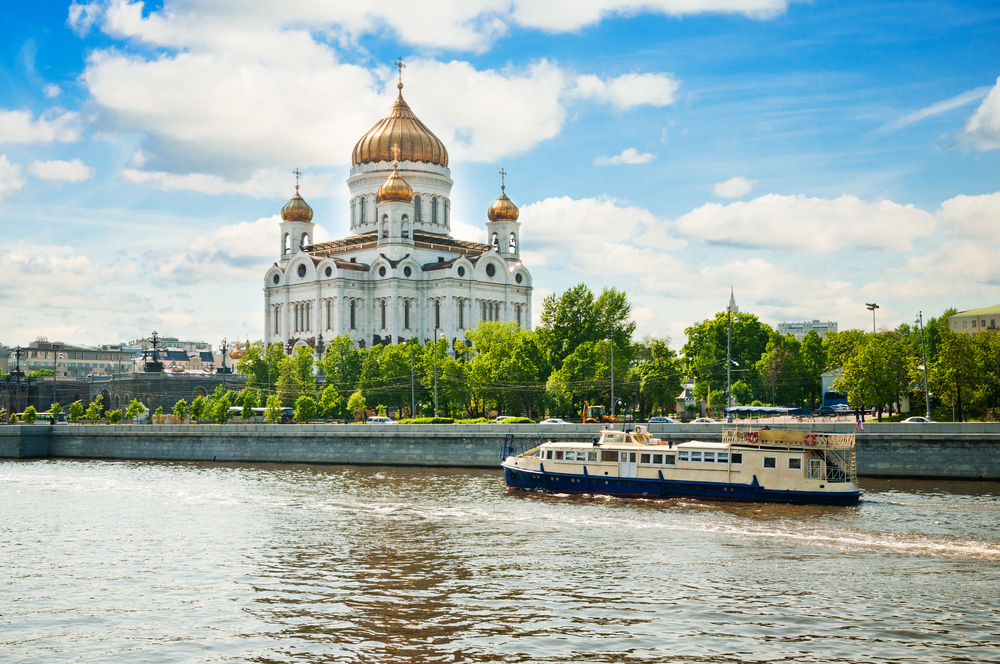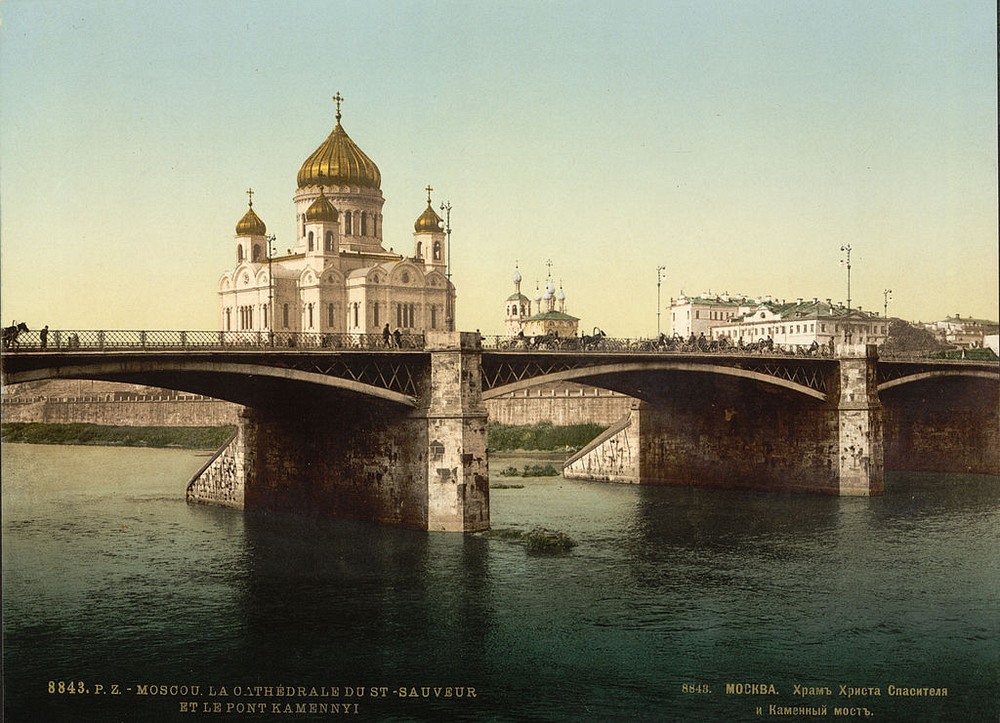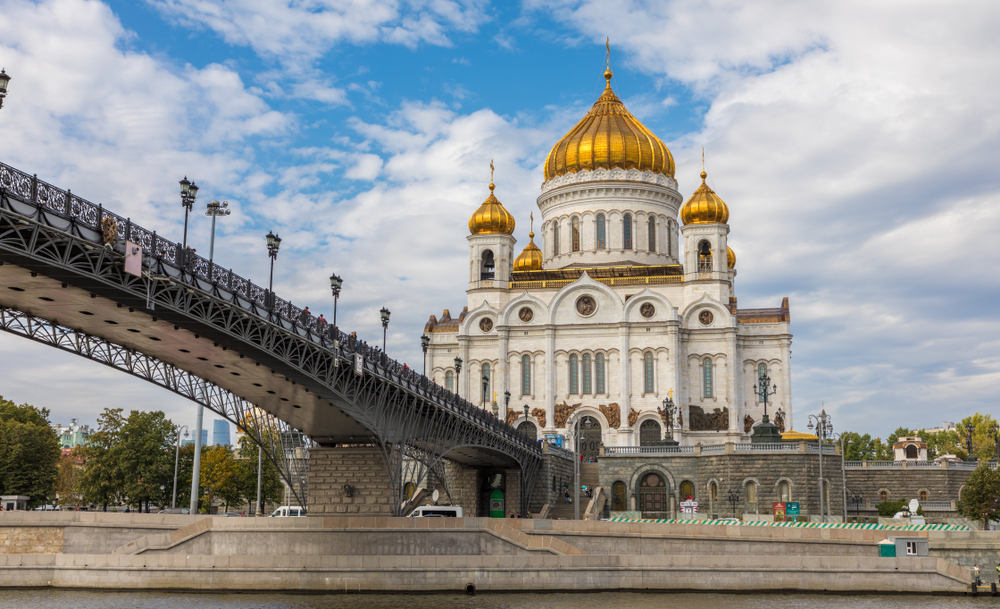History of The Moscow Cathedral  The north bank of the Moskva river in Moscow hosts the Cathedral of Christ the Savior which is the world’s tallest Orthodox Christian church. A footbridge has been constructed for the pilgrims to reach the church from other side of the river. From most of the last 150 years, two churches were built successively. The place was booked by a largest swimming pool of the Soviet Union in the superseding period. Above Photo credit: Valeri Potapova/Shutterstock.com
The north bank of the Moskva river in Moscow hosts the Cathedral of Christ the Savior which is the world’s tallest Orthodox Christian church. A footbridge has been constructed for the pilgrims to reach the church from other side of the river. From most of the last 150 years, two churches were built successively. The place was booked by a largest swimming pool of the Soviet Union in the superseding period. Above Photo credit: Valeri Potapova/Shutterstock.com
The Old Cathedral
The Tsar Alexander I decided to build the Cathedral in the honor of Christ after Napoleon went back from the fatal defeat from Russia. The Alexandar thought that the Russia has won out of harm's way from the doom because of the wisdom of Lord’s divine. An ostentatious neoclassical design occupied with Freemasonic representation was asked by the Tsar. Aleksandr Laverntyvich, an architect, delivered the extraordinary neoclassical design for the Cathedral efficaciously. But the successor of the Alexander I, Nicholas I, was extremely conventional and rejected the freemasonry and neoclassicism of the design. He changed both the site and design of the Church. New location was sited near to Moscow Kremlin and the previous site at Sparrow Hills was abandoned. The new design of Cathedral looked like the Constantinople’s Hagia Sophia. In 1839, Nicholas allowed to build the Cathedral Church after nearly 30 years of Alexander I. Ground was broken in 1839, nearly three decades after Alexander I first expressed his desire to build the cathedral. It took 4 more decades to complete the structure and the old cathedral church finally completed as a holy place in 1883.
The best Russian painters were employed for the inner painting and the interior embellishment of the marvelous building of Cathedral of Christ the savior. The inner shrine of the church was covered by double-storey gallery which was beautifully decorated with rare granite, marble, and stones. One floor of the gallery was occupied by the victories of the Russian emperors and the other floor was reserved for the church choral groups. A thin layer of gold was used to cover the colossal dome of the Cathedral. The interior décor of the church took another 10 years to complete.
However, the beautification of the church was enjoyed for only 34 years. In 1917, the October Revolution started and the Soviet Union took place. The communists of the region did not like the religious behavior of the public and specially a state-owned church. So, the first thing they did was the harassment of believers and promoting atheism. The marvelous Cathedral survived 10 years of such cruelty and dynamited by Joseph Stalin in 1931 finally.
Palace of the Soviets

For the meantime, Soviet officials wanted to build 415 meters high, the largest building at the same place, naming it as the Palace of the Soviets. They wanted the building to use for the celebration of victory of communist and to conduct all important meeting at the great palace. The statue of Lenin was to be stood at the top of building which was 100 meters long. The construction also began in late 1930s, but the dream of standing such huge building for the celebration purpose never came true.
Only the lower levels of the palace were initiated by the steel frames when Hitler came to attack Russia. The construction that was once stopped at that time, never resumed. All efforts to resume the palace remained unused and the building was completely demolished in 1958.
The Pool of Moskva

In 1960, the circular foundation of the great Palace was filled with water and opened for the common public as the largest public swimming pool of the Soviet Union on the orders of First Secretary of Nikita Khrushchev. The pool was able to host more than 20000 people at a time since it had a diameter of 130 meters.

Cathedral Returns
The religious politics began to evade after the end of Soviet Union. At time, Christian communities began to restore their churches and holy places. After the breaking of Soviet Union, the decision to rebuild the church at the same place where it was once the old Cathedral, was taken. The money for the Cathedral was collected from the Muscovites in forms of donation. The pool smashed in 1994, and once again the place became a holy place in 2000.
History of The Moscow Cathedral
 Photo credit: Lids123 / Shutterstock.com
Photo credit: Lids123 / Shutterstock.com
 The north bank of the Moskva river in Moscow hosts the Cathedral of Christ the Savior which is the world’s tallest Orthodox Christian church. A footbridge has been constructed for the pilgrims to reach the church from other side of the river. From most of the last 150 years, two churches were built successively. The place was booked by a largest swimming pool of the Soviet Union in the superseding period. Above Photo credit: Valeri Potapova/Shutterstock.com
The north bank of the Moskva river in Moscow hosts the Cathedral of Christ the Savior which is the world’s tallest Orthodox Christian church. A footbridge has been constructed for the pilgrims to reach the church from other side of the river. From most of the last 150 years, two churches were built successively. The place was booked by a largest swimming pool of the Soviet Union in the superseding period. Above Photo credit: Valeri Potapova/Shutterstock.comThe Old Cathedral

The Tsar Alexander I decided to build the Cathedral in the honor of Christ after Napoleon went back from the fatal defeat from Russia. The Alexandar thought that the Russia has won out of harm's way from the doom because of the wisdom of Lord’s divine. An ostentatious neoclassical design occupied with Freemasonic representation was asked by the Tsar. Aleksandr Laverntyvich, an architect, delivered the extraordinary neoclassical design for the Cathedral efficaciously. But the successor of the Alexander I, Nicholas I, was extremely conventional and rejected the freemasonry and neoclassicism of the design. He changed both the site and design of the Church. New location was sited near to Moscow Kremlin and the previous site at Sparrow Hills was abandoned. The new design of Cathedral looked like the Constantinople’s Hagia Sophia. In 1839, Nicholas allowed to build the Cathedral Church after nearly 30 years of Alexander I. Ground was broken in 1839, nearly three decades after Alexander I first expressed his desire to build the cathedral. It took 4 more decades to complete the structure and the old cathedral church finally completed as a holy place in 1883.

The best Russian painters were employed for the inner painting and the interior embellishment of the marvelous building of Cathedral of Christ the savior. The inner shrine of the church was covered by double-storey gallery which was beautifully decorated with rare granite, marble, and stones. One floor of the gallery was occupied by the victories of the Russian emperors and the other floor was reserved for the church choral groups. A thin layer of gold was used to cover the colossal dome of the Cathedral. The interior décor of the church took another 10 years to complete.
However, the beautification of the church was enjoyed for only 34 years. In 1917, the October Revolution started and the Soviet Union took place. The communists of the region did not like the religious behavior of the public and specially a state-owned church. So, the first thing they did was the harassment of believers and promoting atheism. The marvelous Cathedral survived 10 years of such cruelty and dynamited by Joseph Stalin in 1931 finally.
Palace of the Soviets

For the meantime, Soviet officials wanted to build 415 meters high, the largest building at the same place, naming it as the Palace of the Soviets. They wanted the building to use for the celebration of victory of communist and to conduct all important meeting at the great palace. The statue of Lenin was to be stood at the top of building which was 100 meters long. The construction also began in late 1930s, but the dream of standing such huge building for the celebration purpose never came true.
Only the lower levels of the palace were initiated by the steel frames when Hitler came to attack Russia. The construction that was once stopped at that time, never resumed. All efforts to resume the palace remained unused and the building was completely demolished in 1958.
The Pool of Moskva

In 1960, the circular foundation of the great Palace was filled with water and opened for the common public as the largest public swimming pool of the Soviet Union on the orders of First Secretary of Nikita Khrushchev. The pool was able to host more than 20000 people at a time since it had a diameter of 130 meters.


Cathedral Returns
The religious politics began to evade after the end of Soviet Union. At time, Christian communities began to restore their churches and holy places. After the breaking of Soviet Union, the decision to rebuild the church at the same place where it was once the old Cathedral, was taken. The money for the Cathedral was collected from the Muscovites in forms of donation. The pool smashed in 1994, and once again the place became a holy place in 2000.

History of The Moscow Cathedral
 Photo credit: Lids123 / Shutterstock.com
Photo credit: Lids123 / Shutterstock.com
No comments:
Post a Comment
Note: only a member of this blog may post a comment.